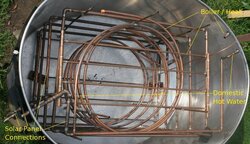Nofossil
Moderator Emeritus
I think I may have posted this picture somewhere, but it's not in this thread. I used an 880 gallon stainless tank from a local stainless scrap dealer / fab shop. I think I paid $350 for it. I put in three HX coils:
1) Domestic hot water preheat (cold well water gets heated on it's way to the hot water heater).
2) EKO boiler / zone coil with rectangular hard copper grids top & bottom.
3) Solar panel rectangular hard copper spiral.
The EKO / zone coil is bidirectional. When th EKO is heating it, it flows top-to-bottom driven by the EKO's circulator. It acts as another zone, in effect. When it's being used to provide heat, it flows bottom-to-top, driven by its own circulator. In that mode, it's effectively another heat source plumbed in parallel to the EKO and the oil boiler. Description of the plumbing here.
It's enclosed in an insulated 'doghouse' under the deck just outside the boiler room.
More description here.
1) Domestic hot water preheat (cold well water gets heated on it's way to the hot water heater).
2) EKO boiler / zone coil with rectangular hard copper grids top & bottom.
3) Solar panel rectangular hard copper spiral.
The EKO / zone coil is bidirectional. When th EKO is heating it, it flows top-to-bottom driven by the EKO's circulator. It acts as another zone, in effect. When it's being used to provide heat, it flows bottom-to-top, driven by its own circulator. In that mode, it's effectively another heat source plumbed in parallel to the EKO and the oil boiler. Description of the plumbing here.
It's enclosed in an insulated 'doghouse' under the deck just outside the boiler room.
More description here.


